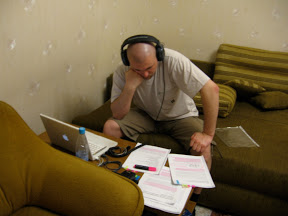Graduation performance with a bang!
Introduction
It is time for HES, where the mass of graduates will present their work. Often the defense is to present the presentation. More often, these presentations without tears can not be watched. The fact is that nobody teaches how to present - present your work. Since I was tired of persistently correcting the presentations of my graduates every time, I decided to reflect my view on how the presentation should look and what typical mistakes exist in this challenging, but fascinating area.

When a student sits down to do a presentation, he primarily looks at the material that he has: modeling results, program architecture, statistics, UI, etc. And all that he has at hand, one way or another gets into the presentation. That is, possessing valuable results, a person seeks to answer the question - “What information should I include in the presentation?”, Which is fundamentally wrong. More precisely, the question is of course correct, but asked at the wrong time.
Correct questions
We know that the right question is half the answer. In our case, at the beginning of the work, the right questions are:
- Who is the presentation for?
- What is the purpose of the presentation?
Answering the first question, we will certainly be disappointed. The point is that the presentation is made for the attestation commission and our task is not to make a fascinating show (which in itself is already sad) - our task is to make a strict report on the work done. In this case, we must disclose a number of precisely defined provisions of our work and meet the strictly allotted time, usually no more than ten minutes. As for the mandatory questions that need to be disclosed in your presentation, their list varies, but always includes the following:
- Work theme;
- the purpose of the work and the tasks necessary to achieve the goal;
- description of the subject area;
- basic concepts and terms;
- key points of work;
- results and conclusions.
The format of the speech must adhere to the traditions adopted in the environment, deviations are possible, but without fanaticism. It is likely that joking with the commission or asking her rhetorical questions would not be the most successful thought.
')
Before proceeding to the formation of the presentation, you should answer the second question. What do you want to achieve with your performance? Approvals? Recognition of the results? In a technical college, the main task is to demonstrate the manufacturability of your solution! A beautiful and thoughtful decision, even if it is redundant, will produce a much greater effect on the commission than a high-quality UI design (although it will be difficult without it) or marketable tricks that sales people love so much. You do not sell a product, you demonstrate what you have learned in five years!
Quantitative indicators
Here you have decided for whom and for what purpose you are making a presentation. You are already targeting the right audience, and you may even have seen last year’s graduate students speak. And then you ask yourself a trump question, - "How many slides to do?". This question is asked by any speaker. You can often find a wonderful answer in the form of 10/20/30 - this is a fairly well-known principle. Its essence is very simple: for 10 slides you will spend 20 minutes of speaking time and the text should be typed in 30m font.
I must say that this principle is not very applicable to the presentation of a thesis. Judge for yourself: if your presentation should be packed in 10 minutes, then there should be only 5 according to the principle, which is much less than even the questions that need to be addressed.

My point of view on this question is as follows: the number of slides should not exceed twenty, with some of the slides you just have to show that they exist, but not dwell on them. For example, the introduction of some concepts in the form of separate slad is necessary, but spending time on explaining them is completely unnecessary luxury.
You should pay attention to which slides will be key in your presentation. I relate to such: purpose, problem, description of business processes, solution architecture, results. Each of these slides should be given a lot of time in your presentation and it should be very high-quality slides. One of the slides must be devoted to the chip of your work, i.e. something that makes it significant and, in a sense, unique.
If possible, devote a small amount of time to alternative solutions. Be sure to make a slide with the merits of your work in relation to competing products.
I have always believed and will continue to adhere to the opinion that one picture can replace a hundred other words. In your presentation, the number of slides with images must be at least half of the total number of slides. But do not insert pictures thoughtlessly; each of your pictures should drive a nail into the commission. Generally try to write the text as little as possible. Competently selected graphic material is at least half of your success. All your images should be vector or, at worst, raster, but in high resolution. Use well-known notations: ER, IDEF, UML, BPMN, but remember: the commission should not have the feeling that you are demonstrating with this: “I stole a product for many kilo boxes and I don’t hide it”.
A lot of formulas are bad! As one famous writer said - each formula reduces the number of readers of your book by at least two. If you are already required to insert mathematical formulas, then use LaTeX for the design of the work, and do not insert screenshots into the presentation.

Registration
If we talk about the presentation as a whole, then it should be said about how to arrange it correctly.
When I look at the presentation, where the slides are decorated in a different style - it makes me nervous. A strict and identical for all slides style design, even with a relatively poor design of the template itself, creates a sense of harmony.
Avoid colorful and frivolous design, use two, maximum three colors in the design. Regarding the color range, you can find the following statement: the light font on a dark background reads better! This is indeed true, but it should be noted that the effect is achieved in a specially prepared room (with dimming and intelligent lighting) on good presentation equipment. Almost in any hall in Russia where I managed to visit, these conditions were not observed.
My recommendation regarding colors: dark text on a light background. Moreover, in this case, it will be much easier to prepare razdatku. Remember that for each member of the commission it is necessary to prepare a set of hand-outs, at least to print out the presentation slides.
By itself, printing a slide as a handout even though it seems like a good idea, but has several drawbacks: the slides will not be provided with your explanations. It is advisable to prepare such materials so that they do not go to the ballot box immediately after your defense.
Try to avoid a lot of ridiculous effects. I can’t imagine who had the idea to add such a number of idiotic jumpers to the presentation builders, which probably allows selling the product to housewives. If you decide to use the effects, then let them be fast, hateful and minimally noticeable.
Use one or two fonts, but no more. Personally, I prefer to use chopped headsets, although many believe that serif fonts are best for text. Forced to agree that for a large text serif headset is ideal. But God forbid you, make a slide on which you place a lot of unreadable text.
The previously mentioned 30th font size is the minimum. In my presentations, I prefer to use 36 as the minimum, and the 46th as a working kegel. A large readable font is a pledge that your text will be seen, and we understand that there are respected people on the commission with a lot of experience behind them.
The use of volume or shadow reflection significantly degrades the readability of the text, although these techniques can be used and sometimes it is beautiful.
Aligning the text to the width or using hyphenation looks idiotic on slides, as in one joke: “well, not really”! And no typesetting of the text in two columns!
Each of your slide should bear some information load, avoid empty slides. Empty both in terms of meaning and in terms of filling. On the other hand, do not overload your slides with information. A remarkable rule: 7 plus minus 2 and large font size are excellent deterrents. I recommend not submitting more than 3–5 abstracts on the slides and avoid tedious transfers.
Try to simplify diagrams and diagrams wherever possible. The graphs and lines in the diagrams should be made in bold lines in a contrasting color. It is desirable to allocate different graphs of different types of lines (as they are different in black and white printing).

One of the attributes of a good presentation is the “end indicator”, made in the form of: headers, time lines, or the banal numbering of pages. The lack of numbering somewhat complicates the process of asking questions.
In drawings, graphs, diagrams and text - that is, everywhere in the presentation, avoid English terms or use them with extreme caution. Eliminate slang from your speech, although I perfectly understand the attractiveness of its use, but the commission will clearly not like it.
Performance
When you have a presentation made in your hands, you should not relax at all, because she herself will not report. When you have a great presentation in front of you, but the report is made dull and confused, this spoils the whole idea of work. That, and look, the suspicion about the unscrupulousness of the speaker will begin to creep in, saying that the presentation from colleagues is skomunizdil - I just want to put an uncertain speaker to the wall.
At the presentation, the people gathered to listen to you, and not to look at how you read the report with a piece of paper. Writing a report on a piece of paper is necessary, first of all, in order to rehearse. Several times rehearse your report and make sure that you fit in time, I recommend making a report a little shorter - you will be nervous, force majeure may occur and the backup time will not hurt you.
For my graduate students, I arrange the so-called runs - performances in a small but friendly environment. Runs allow you to reduce the stress of the performance before the commission and to work out the performance itself in real conditions. It can be said, this is a means of additional control or an air defense system that allows you to remove the shortcomings of the speech in advance, such as the words parasites: it means that this
Also, considerable attention should be paid to the sequence of presentation of the material: during the runs your performance will be tested for strength and for this indicator too.
Try not to forget that the human brain gets tired quickly. As practice shows, you have no more than 3 minutes to interest the public. After time X, the commission begins to be distracted, listen inattentively, at this moment their brain will make a context switch. I have witnessed many cases in which after this moment quite successful performances failed - to keep the audience focused on this whole art. Since the graduate student has no such experience, I recommend at this moment to let the audience go and insert the most uninteresting, but obligatory part into the narration. Skip some specially inserted slides, to which you can always return to answer questions and save time on it.
Immediately after nudyatiny your speech should go up both from an emotional and informational point of view, and end on the rise. The commission will be involved in your presentation, which will leave a good impression about you if you do not blunder with the answers to the questions. When answering commission questions, remember, there are three types of questions:
- The first type of questions is caused by a genuine interest in your work, such “as if” questions give you extra time to talk about work. The questions of the first category are similar to a ball game, the presentation of which in no case should not be missed.
- The second type of questions is questions for self-affirmation, where the author of the question, “as if” makes it clear that he knows more than you, do not disappoint him. There is no need to be afraid of such questions, answer simply, if possible, in monosyllables: yes, no.
- Here the third type of questions is of considerable interest - these are questions with the help of which they want to overwhelm you or pin you up (there are practically no such issues).

General recommendation when answering questions:
- Always listen to the whole question, even if you understand what they want to ask you about (elementary respect).
- If the question seems difficult to you or you do not know the answer, do not extinguish: ask a clarifying question or ask to rephrase the question - this will give you extra time to think.
- Never attack a commission. Do not provoke scandals. Do not be categorical and try to back up slippery answers with references to the opinion of authoritative people in this subject area.
- Never, under any circumstances, answer - “I do not know!”, Even if you really do not know.
Conclusion
It always amazes me how young and beautiful girls come to the exams: bare back, skirt above the knee, neckline so large that you can see the panties. So: all this must be left exactly for one day. Tight suit, tie, white shirt and no sneakers for young people. White closed blouse, skirt below the knee, small-heeled pumps for the beautiful half. Guys need a haircut for a week and shave 12 hours before the performance (from the evening). Three days do not drink, get enough sleep, it is desirable to turn off the Internet.
You shouldn’t keep your hands in your pockets during a performance; you will play at home in a pocket billiard. Do not run around the stage, only minor movements are desirable. Take one hand with the slide slider and the other with cards with important definitions, the format of the cards is no more than half of A4, so as not to attract attention.
Do not look at the floor - it creates an uncertain image. It is advisable to choose one two members of the commission located to you and move the view from one to the other, as if speaking only for them (exclude your manager from the list if he is in the commission). Such behavior creates an additional benevolent attitude from these members of the commission towards you.
First of all, remember that the presentation is you and your story, and the slides are only additional demonstration material. The degree of verbal trust in you depends on how confidently you will act. The commission should have a feeling - “The man said - the man did.” Cut phrases and nails into the audience, but do not overdo it.
Source: https://habr.com/ru/post/95455/
All Articles